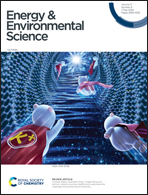Cyano-functionalized pyrazine: an electron-deficient unit as a solid additive enables binary organic solar cells with 19.67% efficiency†
Abstract
Additive engineering has been regarded as a valuable approach for enhancing the power conversion efficiencies (PCEs) of organic solar cells (OSCs). However, the effective solid additive molecules, especially electron-deficient building blocks, that enhance the PCEs of OSCs are still limited. Herein, two cyano-functionalized highly electron-deficient building blocks, namely 3,6-dibromopyrazine-2-carbonitrile (CNPz) and 3,6-dibromopyrazine-2,5-dicarbonitrile (DCNPz), which feature simple structures and facile synthesis are employed as solid additives to optimize the performance of OSCs. It is found that CNPz can modulate the intermolecular interactions and improve the molecular packing, which is beneficial for charge generation, transport, and collection. As a result, a 19.67% PCE is achieved in the PTQ10/m-BTP-PhC6 binary devices, ranking amongst the highest values for OSCs. Furthermore, the general applicability of solid additives is demonstrated in other organic photovoltaic systems. These findings offer valuable insights into designing and developing novel electron-deficient solid additives to boost the efficiency of OSCs.

- This article is part of the themed collection: Celebrating Professor Geoffrey Ozin's 80th Birthday


 Please wait while we load your content...
Please wait while we load your content...